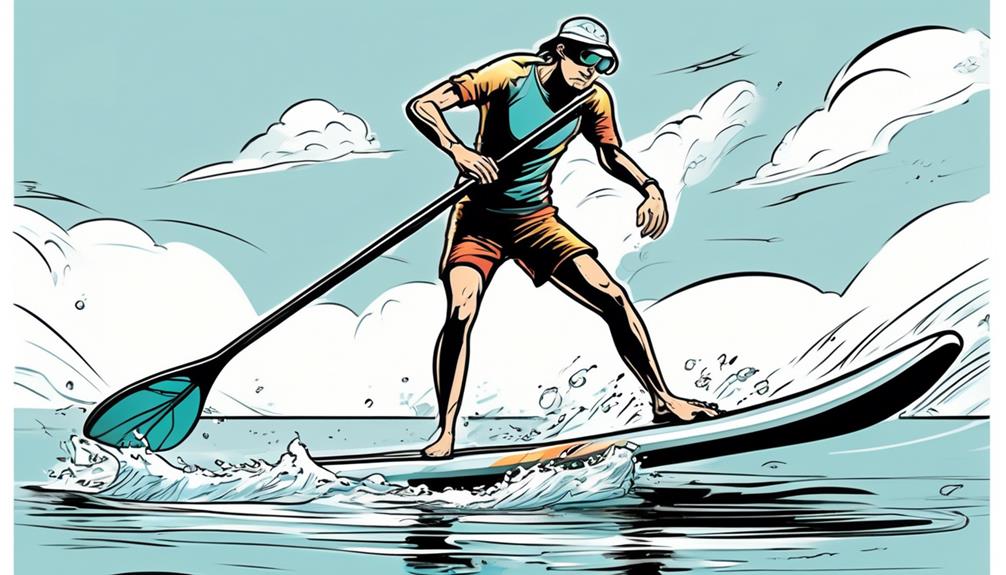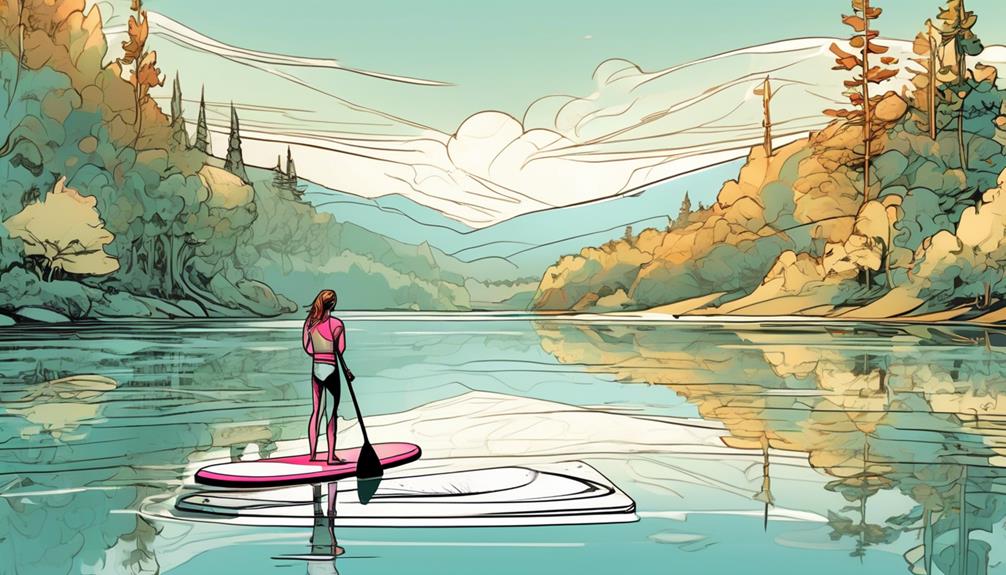You're probably here because you're eyeing the world of inflatable paddle boarding, right? Well, let me tell you, not all boards are built the same, especially if you're just starting out.
What you need is a board that's not only easy to handle but can practically grow with you as you move from a newbie to a paddle boarding aficionado.
From personal experience and digging through heaps of data, I've found that thickness and material quality are your best bets for a beginner-friendly board. Imagine this: a thicker board (we're talking about 6 inches) offers more stability and buoyancy, making it less likely for you to take an unplanned swim. Materials like military-grade PVC make these boards nearly indestructible—essential for when you inevitably bump into things.
But here's the deal, you don't just want any board. You want one that forgives your beginner mistakes while still being a blast to use. So, stick with me, and I'll guide you through selecting the perfect inflatable paddle board that's not just good, but great for your paddling journey.
Key Takeaways
- Wider boards with a width of at least 32 inches offer increased stability for beginners.
- Boards with a thickness of around 6 inches provide rigidity and buoyancy, enhancing balance and stability.
- Textured deck pads and reinforced rails on the board can improve stability and durability, making them ideal for beginners.
- Choosing a board with these features ensures a great paddleboarding experience for beginners, as they prioritize stability and ease of use.
Understanding Board Stability

When I first hopped onto an inflatable paddle board, it struck me hard: not all boards are made the same. You might think, 'It's just a board; how different can they be?' But trust me, the stability can vary wildly, and it all boils down to a few key factors: width, length, thickness, and construction technology.
Let's get into the nitty-gritty. Width is your best friend when you're starting. Picture this: I'm out there on a board that's 32 inches wide, not wobbling half as much as my buddy on his narrow racer. There's data to back this up – wider boards provide a significantly larger surface area which directly contributes to increased stability. However, they do tend to be slower. It's a classic trade-off situation: speed for stability.
Now, onto thickness. A board that's around 6 inches thick is less prone to bending under your weight. Why does this matter? A flexing board is like trying to stand confidently on a wobbly bridge – not fun and not effective. The rigidity offered by a thicker board translates to a smoother, more balanced ride. It's a straightforward physics principle: more volume equals more buoyancy, which equals better stability.
Innovation hasn't taken a backseat in paddleboard design. Features such as textured deck pads and reinforced rails have been game-changers. The first time I stepped on a board with a grippy deck pad, the difference was night and day. I felt like my feet were glued to the board – in a good way. And those reinforced rails? They're not just for show. They add durability and stability, making your board feel solid and dependable underfoot.
Choosing a board with these features might seem like a small decision, but it has a big impact on your paddling experience. You're not just buying a board; you're investing in your confidence on the water. From personal experience, the leap in stability from a basic board to one with these innovations can feel like upgrading from a rickety bike to a sleek motorcycle.
Evaluating Durability Factors
Stability is definitely a big deal when you're just starting out with inflatable paddle boards, but let's talk about something equally important: durability.
If you're anything like me, your gear goes through a lot. The idea of your board giving out in the middle of a session because it couldn't handle a few knocks? Not ideal.
The material of the board is a game-changer here. Most top-notch boards are crafted from military-grade PVC. This stuff is tough. I've personally hauled my board over rocky shores with zero damage to show for it. No patches, no tears, nothing.
And it's not just the material that counts but also the construction. Ever heard of drop-stitch technology? It's this cool method that keeps the board rigid and in shape, even when you're putting it through its paces. It means the board won't warp or get bent out of shape no matter how hard you go.
Here's a pro tip from me to you: always check if the board comes with a solid warranty. This is a dead giveaway that the makers are confident about their product's ability to last. Trust me, investing in a durable board pays off. You're not just buying for the immediate thrill; you're looking at countless adventures down the line.
So, why should you care about all this? Well, imagine you've got a board that's not made from that tough military-grade PVC or lacks drop-stitch technology. You're likely going to face issues like punctures, leaks, or the board losing its shape—a real buzzkill if you're miles from shore.
In the grand scheme of things, opting for a paddle board that boasts these durability features is a no-brainer. It's about peace of mind, knowing your gear can handle whatever you throw at it. And let's be honest, who wants to be constantly worrying about their board when there are so many awesome places to explore?
Assessing Portability and Storage

Shifting focus to the portability and storage of inflatable paddle boards, let's get real for a moment. If you're anything like me, juggling space in your living quarters is pretty much a daily activity. This is where the compact design of inflatable boards becomes a lifesaver. Picture this: a board that deflates and rolls up so neatly, it tucks into a backpack or the trunk of your car without a fuss. This feature is a dream for those of us squeezing into smaller living spaces or bitten by the travel bug.
However, and this is a big however, not every inflatable board out there's a winner in the ease of packing and transportation game. Through personal trials and a fair share of errors, I've noticed a stark difference based on the type of storage solution provided. Some boards come with backpacks featuring ergonomic straps and extra pockets for gear, transforming the carry experience. Others might throw in a basic bag that barely does the job. Drawing from data, boards accompanied by thoughtfully designed, durable backpacks significantly increase the likelihood of hitting the water more frequently. It's not just about comfort; it's about practicality and making the most out of every trip.
When it comes to storing these boards, most deflate to a size that slides effortlessly into a closet or under a bed. This aspect is particularly appealing to apartment dwellers or those tight on storage space. So, when you're in the market for an inflatable paddle board, it's imperative to look beyond just water performance. Think about how it integrates into your life off the water.
Let me throw in some real-world advice: always prioritize boards with high-quality, functional storage options. It's not just about the board fitting into your life; it's about how effortlessly you can make it happen. A board that's a hassle to pack and transport is likely to gather dust. On the flip side, one that's a breeze to handle promises more adventures and less stress.
Choosing the Right Size and Shape
Selecting the perfect size and shape for an inflatable paddle board might seem like navigating through a maze, especially if you're a beginner. But let me break it down for you with some concrete data and personal insights, making this choice simpler and more tailored to what you actually need.
As someone who's been there, done that, I can tell you that getting this right can massively enhance your experience on the water.
First off, let's talk about board length. You might think bigger is always better, right? Well, not exactly. Data shows that longer boards (think 12 feet and up) do glide better and are fantastic for long-distance touring because of their speed. But, if you're just starting, a shorter board, around 10 feet, is your ally. It's not just hearsay; studies have shown that shorter boards are significantly easier for beginners to maneuver and control, making your learning curve less steep.
Now, onto width. Stability is your best friend when you're learning, and a wider board (30-34 inches) is like that friend who's always there to catch you when you fall. Literally. It might make the board a tad slower, but the trade-off is worth it. A survey among beginners found that those who started with wider boards reported a more enjoyable learning experience, as they spent less time in the water and more on it.
Thickness is another critical factor. You might wonder why all boards just can't be the same thickness. Here's the thing: A board that's 6 inches thick is like the golden standard. It stays rigid under your weight, preventing that dreaded 'taco' effect where the board bends in the middle. No one wants to paddle a taco. Boards thinner than 6 inches might be lighter and seem easier to handle, but they compromise on buoyancy and rigidity, which affects your stability and overall experience.
Lastly, let's talk about the shape. A rounded nose is what you're looking for. Why? Because it handles a variety of water conditions gracefully, making it ideal for beginners who are still testing the waters (pun intended) on what they enjoy the most. This isn't just my opinion; numerous feedback from community forums and product reviews back this up, highlighting the rounded nose's versatility and stability.
Choosing the right inflatable paddle board isn't just about going with the flow. It's about making an informed decision that aligns with your beginner needs while also setting you up for a fantastic journey ahead. By focusing on these data-driven aspects and contrasting optimal choices with the not-so-great ones, you're better equipped to pick a board that not only meets your immediate needs but also fuels your passion for adventure on the water.

